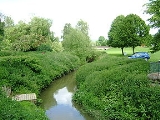
River Teise
Encyclopedia
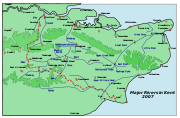
The River Teise is a tributary of the River Medway
River Medway
The River Medway, which is almost entirely in Kent, England, flows for from just inside the West Sussex border to the point where it enters the Thames Estuary....
in Kent
Kent
Kent is a county in southeast England, and is one of the home counties. It borders East Sussex, Surrey and Greater London and has a defined boundary with Essex in the middle of the Thames Estuary. The ceremonial county boundaries of Kent include the shire county of Kent and the unitary borough of...
, England
England
England is a country that is part of the United Kingdom. It shares land borders with Scotland to the north and Wales to the west; the Irish Sea is to the north west, the Celtic Sea to the south west, with the North Sea to the east and the English Channel to the south separating it from continental...
. It begins in Dunorlan Park
Dunorlan Park
Dunorlan Park is a park and grounds in Royal Tunbridge Wells, UK.Totalling approximately 78 acres and containing a lake, the grounds were landscaped by Robert Marnock for Henry Reed, the merchant and philanthropist who owned the estate and the now-demolished house that once overlooked...
in Tunbridge Wells. and flows eastwards past Bayham Abbey and then through Lamberhurst
Lamberhurst
Lamberhurst is a village and civil parish in Kent although the latter parish was at first in both Kent and East Sussex. The line of the county border was adjusted following the Local Government Act 1894, which required that parish boundaries be aligned with counties...
. 2 miles downstream of Lamberhurst the small River Bewl
River Bewl
The River Bewl is a tributary of the River Teise in Kent, England. Its headwaters are in the High Weald, in Sussex between Lamberhurst, Wadhurst and Flimwell. The valley is deeply incised into Tunbridge Wells red sandstone, with a base of alluvium on Wadhurst clay.Between 1973 and 1975, a was...
, on which is the reservoir Bewl Water
Bewl Water
Bewl Water is a reservoir in the valley of the River Bewl , straddling the boundary between Kent and East Sussex. It is about 4 km south of Lamberhurst, Kent, England...
, joins the Teise.
Unusually the Teise bifurcates
River bifurcation
River bifurcation occurs when a river flowing in a single stream separates into two or more separate streams which continue downstream. Some rivers form complex networks of distributaries, especially in their deltas...
1¼ miles (2 km) south west of the village of Marden
Marden, Kent
Marden is a village about 13 km south of Maidstone and civil parish in the Maidstone District of Kent, England. The parish is located on the flood plain of the River Beult near Maidstone. It is on the B2079 road linking the A229 Maidstone with the A21 at Flimwell. It has its own railway...
, passing either side of a low ridge. The Lesser Teise flows for about 4 miles (6.4 km) before joining the River Beult
River Beult
The River Beult is a tributary of the River Medway. It has several sources west of Ashford, including one at Woodchurch. It then flows through Headcorn. At Hunton, above Yalding it is joined by the major stream of the River Teise. Town bridge lies 10¼ miles from Allington, it is the longest...
at Hunton
Hunton
Hunton, as a person, may refer to:*Eppa Hunton , an American politician and generalHunton, as a place, may refer to:*Hunton, Kent, England*Hunton, North Yorkshire, a village in Richmondshire, North Yorkshire, England...
. The Greater Teise, now carrying only minor quantities, flows for about 5 miles (8 km) to the River Medway
River Medway
The River Medway, which is almost entirely in Kent, England, flows for from just inside the West Sussex border to the point where it enters the Thames Estuary....
at Twyford Bridge, upstream of Yalding
Yalding
Yalding is a village and part of Yalding civil parish in the Maidstone District of Kent, England.The village is situated six miles south-west of Maidstone at a point where the Rivers Teise and Beult join the River Medway....
, formerly the site of a double ford over both the Medway and Teise rivers. The Beult flows through Yalding, then also joins the Medway about 6 furlongs (1.2 km) below Twyford Bridge.
Like many other rivers in southern England the River Teise was subject to a Land Drainage Improvement Scheme during the 1950s. The River Lesser Teise was widened, straightened and deepened from Horsmonden
Horsmonden
Horsmonden is a village in Kent, on the Weald. It is situated on a road leading from Maidstone to Lamberhurst, three miles north of the latter place. The nearest railway station is Paddock Wood, Horsmonden railway station having closed in 1961.- History :It was an important centre of the medieval...
to the River Beult confluence. Hence it now carries much of the flow.
The Greater Teise upstream of where the Lesser Teise bifurcates, and the section downstream of Marden to its confluence with the River Medway was also "improved". A number of weirs were built at the time of this work, and still exist today. They split the flows between channels and some are also gauging stations.
Some of the former meanders of the Lesser Teise can still be seen today within retained areas of woodland. These provide a record of the natural character of the River Teise, as does the 4 km bifurcated section of the Greater Teise, which was left largely untouched.
Whilst this work effectively drained the land, it has massively impoverished the ecology of the river, and of course led to a huge loss of floodplain habitat along its course. A significant cost to river wildlife and fishing for the sake of a relatively tiny area of agriculture.
Watermills
The River Teise and its tributaries powered a number of watermills. From source to mouth they were:-Standings Mill, Broomhill, Tunbridge Wells
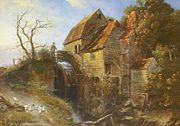
Bayham Abbey Forge
51.105619°N 0.344773°WThis forge was in operation in 1520, when it was leased by William Wybarne. It was still at work in 1667, the pond survives.
Gloucester Furnace, Lamberhurst
TQ 6615 3596 51.098352°N 0.373295°WThis furnace was built in 1695 by William Benge. In 1700 the owner was Samuel Gott. The furnace produced 200 tons of iron in 1717 and John Legas was working it in partnership with William Harrison. William Collins and George Matthews leased the furnace in 1782 but it ceased production c.1787. There was a boring mill marked on Budgen's map of 1795.
Hoadly Forge, Lamberhurst
TQ 6622 3617 51.100218°N 0.374390°WHoadly Forge was built in 1548 by Alexander Collins. It was sold by Stephen Collins to Richard Filmer in 1584. In 1614 it was owned by Sir Edward Filmer and leased to Thomas Sanders and Thomas Ballard. The forge was bought by William Benge in 1694. The railings around St. Paul's Cathedral were cast here.
Furnace Mill, Lamberhurst
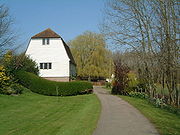
This was a corn mill; the building survives today converted to a dwelling, devoid of machinery except the sack hoist. It was marked on Bugden's map of 1795 and the surviving building dates from c.1812
Hope Mill, Goudhurst
TQ 708 372 51.108518°N 0.440900°WThis corn mill has now been house converted. It latterly worked with two waterwheels. The original wheel against the mill building and the later one set away from the mill. Both wheels were breastshot.
The older wheel
Only the cast iron hub of this wheel remains, on a wooden axle of some 18 inches (457.2 mm)diameter. The wheel had eight wooden spokes per side. This breast shot wheel was 13 in 9 in (4.19 m) diameter by 6 feet (1.83 m) wide, with 48 floats mounted on a cast iron rim. This wheel drove three pairs of millstones by a layshaft.
The newer wheel
This wheel was an overshot wheel, 9 in 2 in (2.79 m) diameter and 9 in 3 in (2.82 m) wide, constructed of cast iron, carried on an 8 inches (203.2 mm) diameter cast iron axle which was unusually long, as it had to pass over the tail race of the other waterwheel.
Goudhurst Paper Mill
TQ 716 392 approx 51.126248°N 0.453270°WThis mill stood on the parish boundary of Horsmonden and Goudhurst. It was first mentioned in 1683, possibly replacing a fulling mill. Owners include George Culvin in 1716, Thomas West in 1725 and Edward Blackwell in the 1730s and 1740s. The mill had closed by 1755.
Marden (Pattenden) Mill, Marden
TQ 735 456 51.183177°N 0.483485°W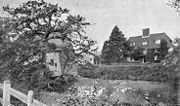
It was run by the Hammond Family, firstly by William, who died in 1808. Then by his son William until his death in 1861. William Jr was followed by his son Henry, who died in 1892 and the mill then ceased working. It was demolished in 1912.
Watermills on the tributaries
The watermills on the River BewlRiver Bewl
The River Bewl is a tributary of the River Teise in Kent, England. Its headwaters are in the High Weald, in Sussex between Lamberhurst, Wadhurst and Flimwell. The valley is deeply incised into Tunbridge Wells red sandstone, with a base of alluvium on Wadhurst clay.Between 1973 and 1975, a was...
are discussed in that article, other watermills on the tributaries were as below.
Benhall Mill, Frant
TQ 607 376 51.115034°N 0.296910°WThis corn mill stood on the site of an old furnace mill. The forge was working from 1557-1653 but disused in 1667. Benhall Mill was not marked on Budgeon's map of 1724. In 1803 the miller was Richard Jones, followed by his son Stephen until c.1845, then Christopher and Henry Smith in partnership until 1870, then Henry alone until 1887. The mill may have continued to grind for Benhall Mill Farm after this date. The remains of the mill were demolished in 1964.
Brookland Forge, Frant
TQ 618 349 51.090463°N 0.311403°WThis forge was sold by Humphrey Lewknor to John Barham in 1521. It remained in the Barhams' ownership until it was abandoned some time between 1629 and 1640. In 1574 Thomas Gresham leased the forge, and sub-leased it to John Carpenter. In 1610 it was leased to Thomas Saunders. There is evidence that the forge had an overshot waterwheel. The dam has been recorded as 65 metres (71.1 yd) long and 1.5 metre high.
Verredge Forge, Frant
TQ 621 352 51.093074°N 0.315818°WThis forge was also owned by the Barham family. It was sold by Humphrey Lewknor to John Barham in 1521. It was leased by Christopher Darrell in 1573 and Thomas Saunders in 1610. The forge was last mentioned in 1642. The dam has been recorded as 120 metres (131.2 yd) long and 3 metre high.
Bartley Mill, Frant
TQ 632 357 51.097254°N 0.331741°WBartley Mill stands on the Winn Stream, just within the parish of Frant
Frant
-Demography:The population of Frant rose steadily from just under 1,100 in 1801 to a peak in 1891 of around 3,500. The records show a marked drop to 1,692 in 1901, but this is due to the transfer of the Broadwater Down parish to Tunbridge Wells that took place in 1894...
, Sussex. Once the property of Bayham Abbey, it was last worked commercially in the 1900s and was restored to working order in 1990. In 1851 the miller was Leonard Latter. The Arnold family were millers here before taking Branbridges Mill
River Medway
The River Medway, which is almost entirely in Kent, England, flows for from just inside the West Sussex border to the point where it enters the Thames Estuary....
, East Peckham
East Peckham
East Peckham is a village in Kent, England, made up of nine hamlets and situated about east of Tonbridge on the River Medway. It was the centre for the hop growing industry in Kent and is still home to the Hop Farm which has the world's largest collection of Oast Houses.-History:The Domesday entry...
in 1890. The last recorded miller was John Ballard in 1905. The mill is open to visitors by appointment.
Bedgebury Forge, Goudhurst
TQ 727 357 51.094471°N 0.467300°WThe site of this forge was destroyed by the construction of the Hawkhurst Branch.
Bedgebury Furnace, Goudhurst
TQ 730 347 51.085396°N 0.471101°WThe site of the Furnace floor is adjacent to the main farm Buildings at Furnace Farm. The Furnace lies just inside Cranbrook Parish. The only Furnace in the Parish, it was owned by Sir Alexander Culpeper in 1574 and let to Sir Richard Baker in the second half of the reign of Queen Elizabeth I. It was let to John Dunnednoll in 1610 and in 1637 John Browne
John Browne (King's Gunfounder)
John Browne was the first holder of the post of King's Gunfounder, which was created in 1615. He was heavily involved in the Wealden iron industry, having control of six furnaces in Surrey and Sussex, two in the Forest of Dean as well as his own furnace between Brenchley and...
was working the forge - there was a dispute about the felling of wood for use at the iron works. George Browne was working the forge in 1657. The forge was disused by 1664, when it was then repaired, but unoccupied again in 1680.
The furnace was recommissioned during the Peninsular War due to the high demand for iron for military and naval purposes, however by 1815 the furnace had all but died again, turning its work from smelt to casting; however its production was limited, as its location made transport costs high compared to furnaces in the Midlands and north-west Kent.
A modified furnace continued in use at Bedgebury for some time for the firing of clay and bricks, produced by the various workshops at Cranbrook Pottery; however the advent of production in the Midlands with better availability of power, transport, labour and materials all but ended hopes of retaining industry in the area.
Bedgebury furnace built new oast kilns in 1880 and again in 1912, for hops from the surrounding hop gardens. The oast kilns remain to this day.
The original bloomery or hammer pond has now silted up but remains as a distinct flat flood plain which clearly defines the approximately 20 acres (8.1 ha) that originally held the water reservoir. A very substantial long pond bay/dam runs north-south and can be seen clearly, nearly 130 metres (426.5 ft) long, 8 metre high and 20 metre wide. The sluice has long been dismantled, however the race is clearly visible to walkers using the bridleway that crosses the river Teise on a stone bridge.
The mill pool is also largely silted up, however immediately north of the pool lies the hammer floor displaying the clear relief of the original working layout.
West of the site is a very large moat which originally held the iron keep.
Brenchley Furnace, Horsmonden
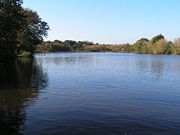
An old site, the Furnace Pond remains today, having an area of some 30 acres (12.1 ha). The dam across the valley is some 140 yards (128 m) in length. the head available being some 30 feet (9.14 m)'.
This furnace was first mentioned in 1574, when the owner was Thomas Bartell or Brattle. In 1579 it was leased by Henry and Thomas Darrell to Thomas Dyke, with Brattle having an interest in the property. In 1588 the furnace was leased by William Ashburnham and sub-leased to Thomas Johnson, a gun-founder. In 1596 the furnace was owned by Sir Thomas Waller, and leased to John Iden and Robert Pothill. The furnace was leased by Thomas Browne in 1604 and later by John Browne
John Browne (King's Gunfounder)
John Browne was the first holder of the post of King's Gunfounder, which was created in 1615. He was heavily involved in the Wealden iron industry, having control of six furnaces in Surrey and Sussex, two in the Forest of Dean as well as his own furnace between Brenchley and...
, who held the office of King's Gunfounder from 1615 to 1681. Some 200 men were employed at the furnace in 1613. The furnace was working to at least 1667 and in 1744 there was a boring mill run by one Harrison.

